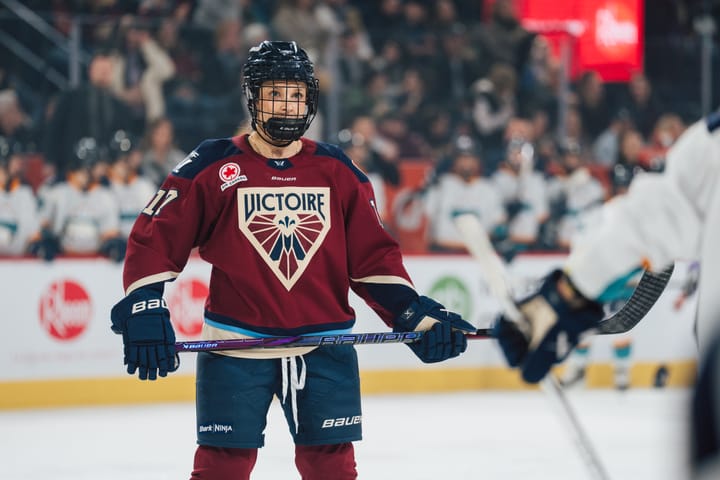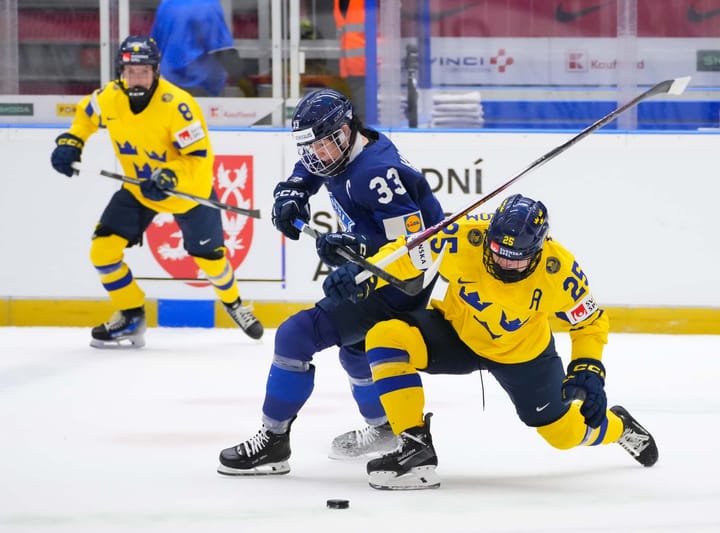Her Own Person: Talk about female athletes, not their male relatives
Why we need to stop talking about a player’s lineage and focus on the player
If you have ever watched an international women’s hockey competitions such as the Olympics or the Women’s World Championships, you have heard the commentators say “Alex Carpenter, daughter of former Bruin Bobby Carpenter” or talk about Amanda Kessel’s two-time Stanley Cup Champion brother. Or, perhaps, they have included the fact that Laura Stacey is the great-granddaughter of NHL legend King Clancy?
When commentators link a player to a famous male relative, they shift focus away from the player herself. It distracts from her being seen as an individual athlete who worked hard to get where she is. No longer is she four-time Women’s World Championship gold medalist Alex Carpenter; now she’s Bobby’s daughter who happens to have played for the U.S. National Team. Phil’s sister, not Amanda Kessel, scores the shootout extending goal in the gold medal game. King Clancy’s great-granddaughter scores the Clarkson Cup-clinching goal, not silver medalist Laura Stacey.
Double Standard
A 2017 study found that women doing the same work as their male counterparts are less likely to be promoted. These findings suggest the reason is an unconscious structural bias that undervalues women’s work. The researchers also put forth an alternate theory: that women are often seen as mothers first and workers second. They cited a 2014 study on the motherhood penalty, which found that women are penalized for having children. The same study found men were rewarded for fathering children. Gender stereotypes like this only reinforce the societal perception a man’s achievements are more important than a woman’s.
The same double standard is applied to women’s hockey. Consider what happened to Jocelyne Larocque after she took off her silver medal in PyeongChang. She was openly mocked for showing emotion after losing a gold medal to her team’s historic rival. American fans taunted her with calls of, “Put your medal on!” The IIHF went as far as ordering her to wear it for “legal reasons.” This incident happened a month after Swedish player Lias Andersson, after losing the World Juniors to Canada, threw his silver medal into the crowd. Andersson apologized and was quickly given a pass for his actions for being a teenager. Larocque apologized almost immediately but was still criticized for being “unsportsmanlike” and “un-Canadian.”
More recently, former Canadian Olympian Gillian Apps and American Olympian Meghan Duggan got married. Congratulations came from all over the women’s hockey community, including USA Hockey. Even Vanity Fair covered the nuptials.
And then there was this:
Congratulations to Team USA captain Meghan Duggan and Team Canada forward Gillian Apps on getting married over the weekend!
— Complete Hockey News (@CompleteHkyNews) September 24, 2018
Apps is the granddaughter of Hockey Hall of Famer Syl Apps and the daughter of former NHLer Syl Apps Jr. pic.twitter.com/KxWZlbXt1U
For seven years the two battled in women’s hockey’s biggest rivalry. The decorated couple has six Olympic (4 gold, 2 silver) and sixteen IIHF Women’s World Championship (10 gold, 6 silver) medals between them. Instead of mentioning those achievements, Complete Hockey News chose to comment on Apps’ lineage.
Apps has more Olympic golds than Sidney Crosby (Apps 3, Crosby 2) but his family is rarely a topic of conversation. (We only heard about his sister when she made a joke in her St. Cloud State bio). When Alex Ovechkin got married, there was no mention of his mother two-time Olympic gold medal basketball player Tatyana Ovechkina in the press release. Both Duggan and Apps are among the most accomplished athletes in their sport. Shouldn’t that be enough?
Educating Fans
Many hockey-oriented media unfamiliar with covering the women’s game fall into the familiar trope of “educating” fans. They talk about previous Olympic or international competition experience. They mention Frozen Four appearances, NCAA achievements. Occasionally they mention if and where they play professionally. They mention family, and more specifically family with NHL ties.
Prior to the Olympics, USA Today published an article on Stacey’s relation to King Clancy; three of the ten paragraphs briefly spoke of her accomplishments. NBC did an entire segment on them during their Olympic coverage. It’s important to note Clancy passed away several years before Stacey was born. Her only direct link to him is via her great-uncle, Terry Clancy, who also played in the NHL.
The media’s unfamiliarity with the women’s game often leaves them looking for something they can use to connect their experiences. Commentators of international games tend to work for men’s hockey (usually the NHL) during the regular season. Because of this they compare women’s players to their NHL counterparts.
Although not malicious in intent, comparing the two does a disservice to women hockey players. It implies that the men’s game is better than the women’s. It’s no secret women players have a harder time breaking into the game. According to the Women’s Sports Foundation, most girls drop out of sports around age 14. The lack of co-ed/girls youth leagues and limited funding restrict girls’ and women’s development opportunities. The loss of women’s college programs, like the University of North Dakota, also limit players’ opportunities. Then there’s the lack of equal pay from USA Hockey. Neither the NWHL or CWHL pay a living wage. European leagues are underfunded and players make little to nothing at all.
Relevant Topics of Conversation
What should commentators talk about instead of players’ coincidental connection to the NHL? One obvious answer is the athlete’s own accomplishments. Instead of comparing Amanda and Phil Kessel, talk about Amanda’s return to hockey after a concussion and her scoring the game winning goal to clinch the University of Minnesota’s 2016 NCAA Championship. If there should be a need to talk about siblings playing hockey, the NBC coverage of the Brandt sisters during the Olympics is one example of how it can be done.
Meghan Agosta becoming a constable for the Vancouver PD is a common topic of conversation when she’s on the ice. There are other notable players who are also first responders. Hilary Knight’s former Boston Pride teammate Brittany Ott is an Emergency Medical Technician. Laura Stacey’s current Markham Thunder teammates Nicole Brown and Liz Knox are training to become firefighters.
References to the NHL can and should occur. There are ways to do it that still emphasize the accomplishments of the women athletes. When Alex Carpenter was on the US National Team, the most obvious reference was to her father, Bobby Carpenter. Mention how his daughter playing for the Boston Pride allowed him to connect with Denna Laing. Because of that connection, the two collaborated to run the Boston Marathon to raise money for their charities.
Former Canadian Olympian Hayley Wickenheiser was named the assistant director of player development for the Toronto Maple Leafs. Former Olympian Jayna Hefford became the sixth woman elected to the Hockey Hall of Fame. Additionally, she took over as interim CWHL commissioner after Brenda Andress stepped down in August.
There are a myriad of hockey related stories involving players that can be told during a broadcast that do not relate to an athlete’s NHL family ties. USA Hockey and Hockey Canada routinely include personal tidbits about players in their profiles. Similar stories are in the NCAA, CWHL, and NWHL profiles. There is information available and stories waiting to be told.
Ed. note: TIG Staff byline denotes a group effort on a post. It represents the work and views of many on The Ice Garden.





Comments ()